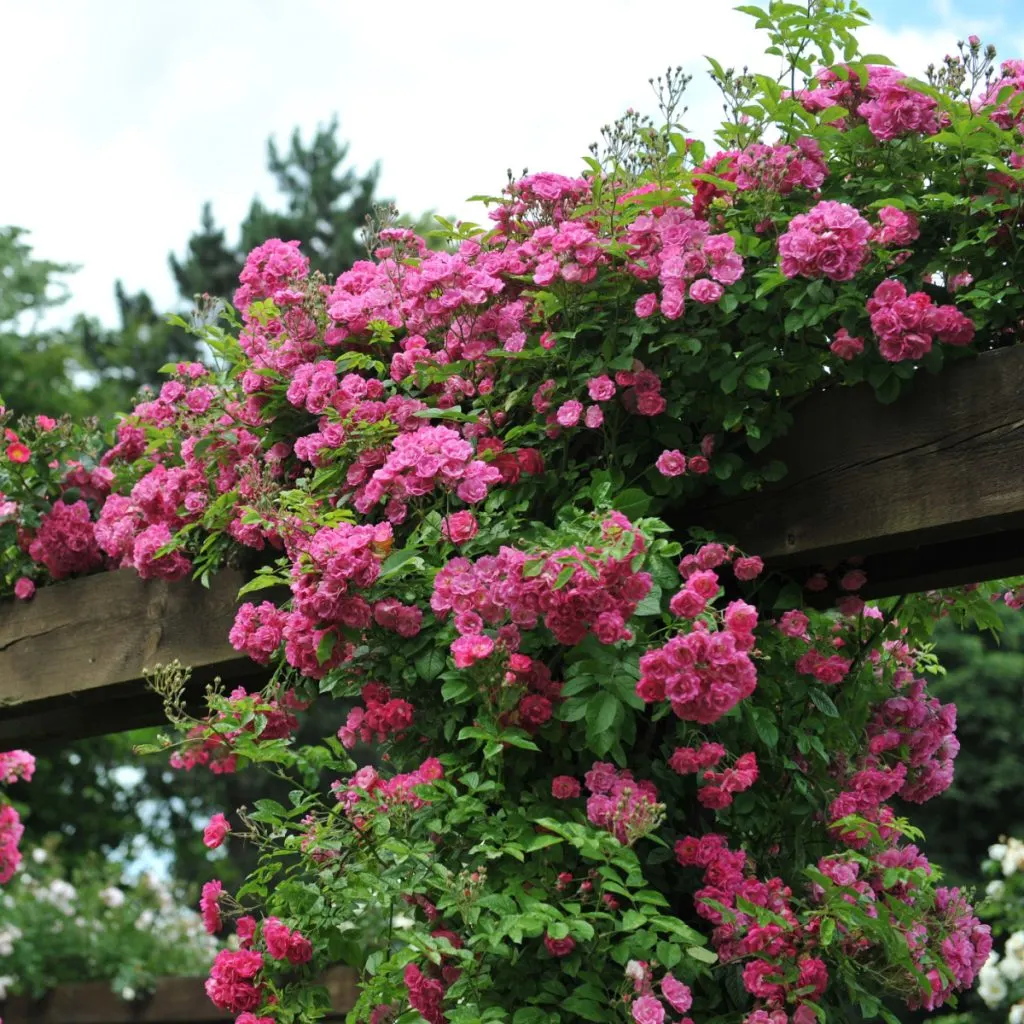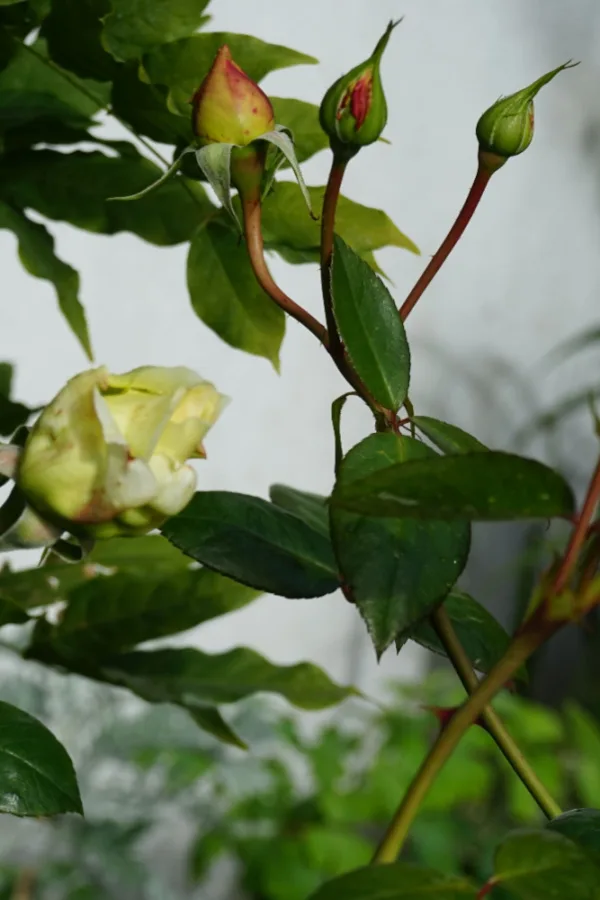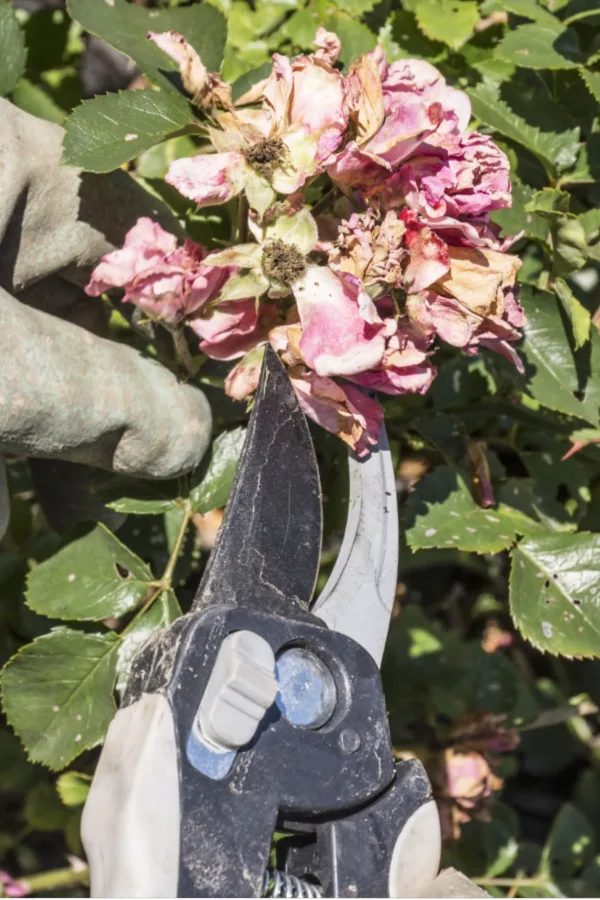When it comes to fertilizing your climbing roses and keeping them gorgeous and blooming all summer long – a few simple tips can go a long way to big flowering success!
It’s hard to beat the elegance of a climbing rose. Whether gracefully growing up an arbor, trailing along a fence line, or meandering up a trellis, climbing roses can certainly fill a space with beauty.
Of course, this is especially true when the foliage is overflowing with a mass of colorful blooms. But the real question for many gardeners is how to get those blooms to last as long as possible. And to keep on coming back. After all, even though the rose’s foliage might be attractive, its blooms are what adds so much stunning color to the landscape!

The good news is that unlike many traditional rose bush varieties, a climbing rose bush can repeat its bloom cycle several times throughout the growing season. Not only will they bloom on old growth, but new growth that has emerged during the season as well. That is, as long as it has the power to fuel those blooms!
How To Fertilize Climbing Roses – And Keep Them Blooming All Summer!
Although it will depend a bit on the variety you are growing, most climbers will bloom several times throughout a season. But in order to get them to flower consistently, there are three important tasks a gardener needs to perform a few times throughout the summer – fertilizing, deadheading old blooms, and light pruning.
Fertilizing is vital for providing the nutrients roses need most. Especially when you provide the energy they need most to promote flowering – and give it to your bushes at the right time. Deadheading and pruning meanwhile help to revitalize the plant, forcing it to bloom again and again.
If all three above are done properly and consistently, it will have your climbing rose bushes blooming from late spring right into late fall – and with gusto! Here is a look at each of the three tasks, and how to get them just right for season long flowering.
Fertilizing – How To Keep Climbing Roses Blooming
One thing is for sure, blooming requires energy. Not just a little, but a lot of it! Over time, perennial plants like climbing roses can deplete the soil where they grow of the nutrients they need most for blooming. And that is exactly where fertilizing can pick up the slack.

When it comes to climbing roses, the key for helping them bloom stronger is to supply the nutrients they need at just the right time. In the case of a climbing rose, that means giving them a dose every time they end one blooming cycle and begin to head into a new one.
Selecting The Right Fertilizer For Climbing Roses – How To Fertilize Climbing Roses
In the early spring, just as the first buds begin to form, it’s time to fertilize for the initial bloom set. For climbing roses, it’s always best to use a fertilizer with slightly more phosphorous than nitrogen and potassium.
Climbing roses still need nitrogen to grow. They also use potassium as well to maintain overall plant health. But when it comes to powering blooms, it is phosphorous that is most important. Because of that, the amount of phosphorous in your fertilizer should be slightly higher.
Look for a fertilizer with an N-P-K (nitrogen, phosphorous and potassium) somewhere in the range of 4-6-2 to 4-6-4. This will provide the perfect balance of all three to promote healthy roses with far more blooms. Product Affiliate Link: Dr. Earth 4-6-2 Total Advantage Rose and Flower Fertilizer
You should also fertilize your climbing rose again each time a blooming period ends and a new one is about to begin.
As a general rule of thumb, most climbing rose bushes will have a major bloom in late spring. After that, they will usually have two to three more bloom sets about every 4 to 6 weeks of the season. That is – as long as they are deadheaded and lightly pruned after each flowering.
Deadheading For More Blooms – How To Fertilize Climbing Roses & Keep Them Blooming
Just as with most perennial and annual flowers, removing spent blooms is vital to keep climbers blooming. The longer a decaying flower remains on the plant, the more issues it will cause.
When an old bloom is left on a plant to decay, it continues to draw resources from the plant. Nearly all plants naturally try to fix or heal any living part that grows from their roots. The same goes for climbing rose bushes.
But by regularly deadheading or removing spent blooms, you can help the plant put its resources where it counts the most. And that means using the energy for producing new growth and blooms.
To keep your climber blooming longer and stronger, take time every few days to snip off old blooms. The more you can clear from its branches, the more power it will have to use to create more. And when your climbing rose bush is getting near the end of its entire flush of blooms, it’s time for a light pruning to set the stage for a new flowering session.
Pruning – How To Fertilize Climbing Roses & Keep Them Blooming
In addition to frequent deadheading, light pruning at the end of each bloom session can help conserve plant energy and prepare the plant to set new buds.

This is a more thorough removing of old blooms. It can usually be done quite easily with a pair of hedge trimmers. Simply take them lightly to the bush to trim off any old blooms and a bit of foliage.
At this point, also take time to cut back wild-growing shoots. Long runners and rogue growth branches consume a tremendous amount of the plant’s energy. Especially when you consider these types of off-shoots rarely produce many blooms.
In addition, always remove any and all broken limbs or ones that show signs of disease or other damage. Just as with keeping old blooms on the plant, when any damage occurs to a plant, it will use available resources to attempt to heal the issue.
Then, as soon as you lightly prune – it’s time to give your climbing rose another dose of fertilizer. This will both help the plant to recover from the last bloom session and pruning. Even more, it will also power a new set of buds.
Long-Term Care – How To Fertilize Climbing Roses & Keep Them Blooming
There are a couple of other helpful tips for getting the most from your climbers. At season’s end, mulch your climbing rose with a healthy dose of compost before winter settles in.

The compost not only acts as a protective mulch, it also slowly recharges the nutrients in the soil. That can be crucial for helping your roses the following spring. This, just as with fertilizing, it can help power early growth and a faster set of blooms.
Using compost in the fall is the best way to give them power for next year. You should never fertilize your roses in mid to late fall. This type of power can spur on new growth that can then leave the plant vulnerable to winter damage.
In addition, take care to keep trailing branches secured to whatever support structure your rose is climbing on. The more secure the branches and stems, the less likely damage will occur during inclement weather. See: How To Prepare Rose Bushes For Winter – The Secrets To Fall Rose Care!
Here is to growing climbing roses – and to getting them to bloom again and again all summer long!
This Is My Garden
Follow Our Facebook Page For Great Gardening Tips And Advice! This Is My Garden Facebook Page
This Is My Garden is a garden website created by gardeners, for gardeners. Jim and Mary Competti have been writing gardening, DIY and recipe articles and books and speaking for over 15 years from their 46 acre Ohio farm. They publish three articles every week, 52 weeks a year. Sign up today to follow via email, or follow along!

